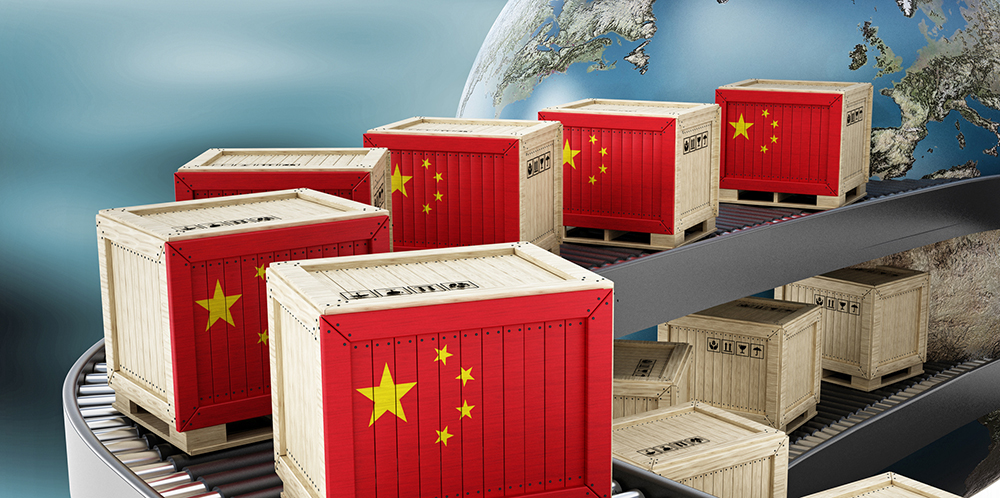The Chinese Economy Shifts From Major Exporter to Major Importer

Chinese Economy
The Changing Face of China’s Economy
Made in China – The ubiquitous label you find on everything from clothing to kitchenware, toys to sports equipment may be shifting. While the United States occupies the top slot as the largest economy in the world, China is a close contender, and in 2016, China was the world’s number one exporter out of 221 countries, generating $2.27 trillion. That same year, Chinas was the number two importer behind the United States, totaling $1.23 trillion. According to the Observatory of Economic Complexity (OEC) – the world’s leading visualization engine for international trade data – China’s top exports are computers, broadcasting equipment, telephones, integrated circuits (semi-conductors and microchips) and office machine parts. Top imports include crude petroleum, gold, iron ore and cars. Historically, China was the primary exporter for the United States, Hong Kong, Japan, Germany and South Korea, but spurred by shifting global trends, a growing consumer market and trade tariffs with the United States, economists say that China is shifting from the top global exporter to become top global importer as well.
China’s Economy Shift – Global Economic Trends and Consumerism
According to the China International Capital Corporation (CICC), with ongoing global and domestic economic trends, China is anticipated to become the world’s largest importer of global goods by the year 2022. Affecting this import trajectory are such influences as the stabilization of the Chinese economy and an overall increase in the price of global commodities. This swing in position from exporter to importer will have far reaching effects on the rest of the world, as China currently imports goods from roughly 41 countries versus the United State’s 36 countries. It is also anticipated that along with industrial materials, China will eventually represent the world’s largest consumer market, with its burgeoning middle-class surpassing the United States by importing more and more consumer-related products to satisfy its growing consumer population.
The Future of the Chinese Economy
This year marks the 40th anniversary of the Chinese government steering away from its communist roots to enter the global stage as a major influencing force through widespread economic reform. The shift began under former leader Deng XiaoPing and continues under current leader Xi Jinping. During the past 40 years, China has opened itself up to international trade and has become a key player in the modernization of global industry. Over the past few decades, it has transformed its economy in unprecedented ways, elevating hundreds of millions of Chinese citizens out of a state of poverty and into a consumeristic bracket. Consumer spending has been, in essence, the pillar of China’s modern economic architecture, but with that, it now also faces for the first time the phenomenon of consumer debt. In response, the Chinese government is leaning on stimulus measures, tax cuts, investments in infrastructure, relaxed monetary policy and overall, “pro-growth measures.” Time will tell how these measures will shape the country’s economy, for better or for worse as it evolves as a key player on the world stage.
The Far Reaching Effects of the Trade War
In tandem with the anniversary of the country’s economic reform movement, 2018 has been rough on China’s economy. As a result of the trade war with the United States, which slapped extreme tariffs on both Chinese imports and exports, the Chinese economy has also felt the draining effects of rising debt levels. After billions of dollars in tariffs were placed on Chinese goods in early 2018, both the United States and China are negotiating trade agreements that are expected to reach a conclusion by February 2019. If the two global giants are unable to reach a satisfactory agreement in the early part of 2019, tariffs are likely to increase and China will continue to feel that burn, causing an economic ripple effect that will be felt across the world. The trade war between the United States and China is not simply a matter of tariffs being placed on goods and commodities. According to CNN Business, It also represents an ideological and cultural rift between the two nations that stems from differences in perspective on “Technology, intellectual property, investment, industrial policy and access to its markets.”
The Bottom Line
The coming year will be a pivotal time for China as an economic global force. As it trends more and more in the direction of becoming the world’s largest importer of goods and commodities in conjunction with its growing consumer population, the outcome of trade war negotiations and the curbing and management of domestic lending practices will be instrumental in determining how its economy fares. As a result, the world economy – including the economy of the U.S. – will respond to these trends and fluctuations in unforeseen ways.
Contact an SCL Consultant Today
In a wide range of industrial sectors, SCL is committed to being the number one logistics and solutions provider for the products that protect and optimize the machines that keep our country moving. We pride ourselves on remaining at the forefront of industry trends and technological innovations, and as the market continues to evolve, we are committed to providing extensive product and industry knowledge and total performance satisfaction for our customers. For information on how we can assist your fleet in choosing the optimal products at a competitive price, contact an SCL consultant today.
